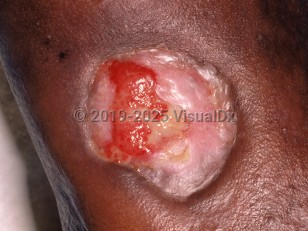Pyoderma gangrenosum in Child
See also in: Cellulitis DDx,AnogenitalAlerts and Notices
Important News & Links
Synopsis

PG can take on a number of differing clinical presentations. The 2 most common presentations in adults are a classic ulcerative form, which often involves the lower extremities, and a vesiculobullous form, which is more superficial and tends to occur on the upper extremities, including the hands, and is most commonly seen in patients with an associated lymphoproliferative disorder. Other variants include pustular, vegetative, and peristomal PG. PG can affect any age, but it is rare in the pediatric population. Pediatric PG has more pustular lesions and has a strong association with inflammatory bowel disease (IBD).
Fever, toxicity, and pain can be associated with the onset of PG. Rarely, PG can involve the eyes. Extracutaneous manifestations may take the form of sterile neutrophilic abscesses, such as in the lungs, heart, gastrointestinal (GI) tract, liver, eyes, central nervous system (CNS), and lymphatic tissue.
Necrotizing neutrophilic dermatosis describes a subset of patients with severe acute febrile neutrophilic dermatosis (Sweet syndrome) or PG who, in addition to their cutaneous disease, develop fever, leukocytosis (or a leukemoid reaction), and features of shock. Skin pain is a prominent symptom. Additionally, soft tissues underlying areas of skin involvement may be affected with neutrophilic infiltrates and necrosis.
Although the exact cause of PG is unknown, neutrophil dysfunction, inflammation, and genetics are all thought to play a role. Additionally, PG has associations with a number of systemic illnesses. In the majority of pediatric cases, there is an association with IBD (Crohn disease or ulcerative colitis), but other associations in this population include juvenile idiopathic arthritis, inherited and acquired immunodeficiencies, leukemia and other hematologic disorders, and a range of rheumatologic disorders, including systemic lupus erythematosus and autoinflammatory syndromes (eg, PAPA syndrome [pyogenic arthritis, PG, and acne], PASH syndrome [PG, acne, and hidradenitis suppurativa], and PAPASH syndrome [pyogenic arthritis, PG, acne, and hidradenitis suppurativa]).
PG can have either an acute or chronic course and result in extensive scarring (which can be cribriform or keloidal with dyspigmentation, especially in patients with darker skin colors). Surgical intervention is a common exacerbating factor because PG demonstrates pathergy, a phenomenon by which skin trauma can lead to worsening disease.
Codes
L88 – Pyoderma gangrenosum
SNOMEDCT:
74578003 – Pyoderma gangrenosum
Look For
Subscription Required
Diagnostic Pearls
Subscription Required
Differential Diagnosis & Pitfalls

Subscription Required
Best Tests
Subscription Required
Management Pearls
Subscription Required
Therapy
Subscription Required
Drug Reaction Data
Subscription Required
References
Subscription Required
Last Updated:10/23/2023

